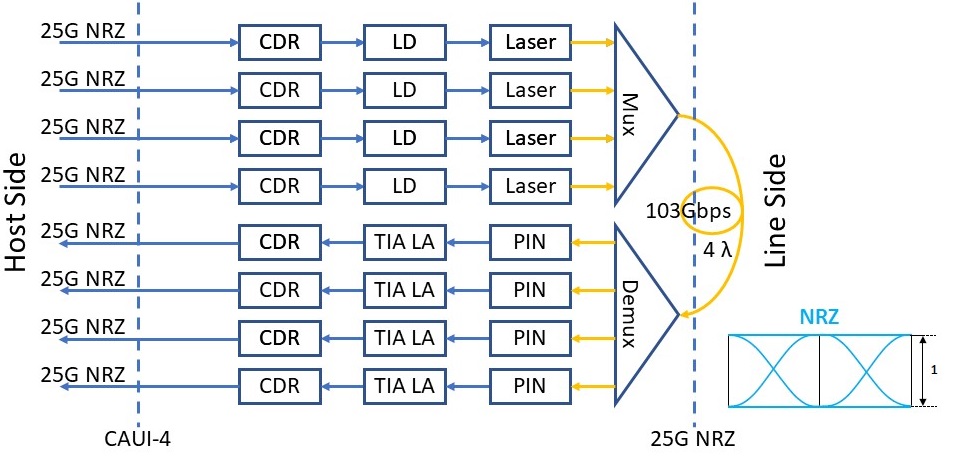Existing 100G infrastructure and technology were not keeping pace with the insatiable needs for high-speed networks and data center customers’ demand for lower costs. In order to meet these requirements, researchers began developing a technology which would bring down costs significantly and at the same time, be compatible with future generation networks. This led to the development of single-lambda transceivers. So, let us dive deeper to understand what the single-lambda technology is and how will it bring down overall costs.
What is single-lambda technology?
As the name suggests, the technology only uses 1 wavelength to transport data optically. The existing 100G (QSFP28) technology has different flavors defined by the IEEE and MSA as SR4, LR4, PSM4 and CWDM4. These optics use 4 lanes of 25Gbps NRZ (Non-Return to Zero) signals in order to achieve an aggregate data rate of 100Gbps. In doing so, they either use a multiplexer to combine the 4 wavelengths or use 4 parallel optical channels to send data. On the contrary, 100G QSFP28 single-lambda technology uses a single 50GBaud PAM4 signal to achieve data rate of 100Gbps. PAM4 carries twice the data that a NRZ signal can carry. Since, it only uses a single wavelength, there is no need for a Mux/Demux unit to separate the wavelengths. The single-lambda technology relies on a Digital Signal Processor to convert the 4 electrical signals (@25Gbps NRZ) to be converted to a single 50GBaud PAM4 signal. This signal is then propagated using a single-wavelength (typically 1310nm).


How does Single-Lambda improve cost?
The 100G optics like LR4, SR4, PSM4 and CWDM4 use Clock Data Recovery (CDR) at both transmitter and receiver for every electrical lane. They also use Trans-Impedance Amplifier (TIA) + Linear Amplifier (LA) & PIN photodiode for all electrical lanes at the receiver and Laser Driver (LD) & Laser at the transmitter. In addition to that, some of them also Mux at the transmitter and Demux at the receiver. All these components increase the overall complexity and cost of the transceivers.
On the other hand, the 100G single-lambda optics only use a single DSP with CDR at the transmitter and a single DSP with CDR at the receiver. In addition to that, they only use a single LD & laser at the transmitter and single TIA + LA & PIN photodiode at the receiver. This reduces the number of components and overall complexity of the design thus bringing down the overall cost by up to 40%.
Compatibility with future generation networks
The current networks are pushing for higher data rates of 400G. The QSFP-DD uses 50GBaud PAM4 lines to achieve an aggregate data-rate of 400G. Since, this technology uses PAM4 signaling, it is backward compatible with 100G single-lambda technology which also uses PAM4 signaling. The 400G spec for single-lambda (500m reach) is defined as DR4 while the 100G spec for single-lambda (500m reach) is defined as DR1.
If you have any questions on 100G transceivers, contact us at info@vitextech.com.
Related Products

